April 2012 archives
you are here [x]: Scarlet Star Studios > the Scarlet Letters > April 2012
<< before
February 2012
after >>
June 2012
April 27, 2012
stopmo interview with elizabeth carmona
by sven at 2:40 am
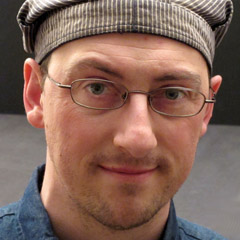
Elizabeth Carmona, a graphic design student in El Salvador, is doing her graduation thesis research on stop-motion. She found my work via StopMotionAnimation.com and asked for an interview. I have a hard time saying no to pontificating about the subject — particularly if it might help an emerging artist — so here's what came of it...
Eliza: Thanks a lot for your answer and for agreeing to help me!
I'm doing a guide about "How to do stopmotion animation", and I was reading your site and it has such a wonderful information about the technique (I specially find really useful and interesting the essay about pros and contras of cg, and the aesthetics of stopmotion) and the way you've been experimentating with armatures.
So for the interview I wanted to ask you:
Why did you choose stop-motion?
Sven: Stop-motion is something that I've wanted to do since I was maybe 6 years old. I read books about animation and special effects because I was in love with Star Wars and films like it. But animation seemed impossible then. I just couldn't see myself shooting on film and then having to send it off for developing. In 2002, one of the books I'd read as a child — The Animation Book, by Kit Laybourne — was republished with new material about computers. Suddenly it dawned on me: all you need now to do animation is a computer — and I've already got one of those. So I started doing motion graphics and kinestasis using AfterEffects. But it still felt like something was missing. I enrolled for a hands-on class about shooting Super8, so I could say I'd at least tried using celluloid. In the process of doing that, I finally got my chance to try stop-motion. And when I did, I was hooked. It was like a fever. For at least a year, it seemed like I did nothing but study stop-motion and experiment with puppet-making materials. I could talk about the various things I love about stop-motion — how you're making real, tangible objects come to life (magic!) — but the attraction goes beyond reason. I bonded with stop-motion at a young age, and late in life am unable to shake its gravitational pull.
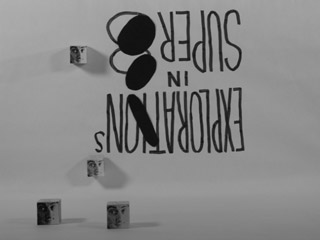
Who have been your influences?
I fell in love with Star Wars, King Kong, all of Ray Harryhausen's films... There's a lineage there, that goes from Willis O'Brien to Uncle Ray to Phil Tippett. But while the sci fi / fantasy stuff is ingrained in my bones, it's actually the more stylized, artsy puppet animation that I'm interested in making myself. There's another lineage: which goes from Vladislav Starevich's The Cameraman's Revenge to George Pal's Puppetoons to Henry Selick's The Nightmare Before Christmas. In the current scene, I'm most inspired by folks like Jeff Riley (Operation: Fish), Neil Burns (The Nose), Nick Hilligoss (L'Animateur), and Barry Purves (Tchaikovsky - an elegy).
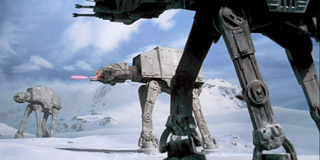
From where do you take inspiration for a new story or character? what comes first for you?
I'm very interested in process. Story and character are important, but pretty much everything I've done so far has begun from wanting to tackle a specific technical challenge: such as lipsync or replacement faces. Time has also often been a consideration — challenging myself to make a film in a set number of days or weeks. I find that by starting with the limitations I want to obey, I'm less likely to get sucked into attempting a project that's too big to be completed in a tolerable amount of time.
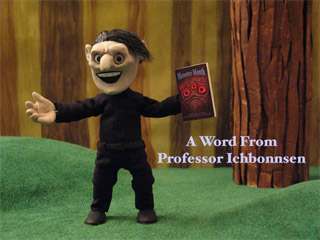
While making the puppet, what are the most important things you consider?
A puppet is only as good as its armature. To get really nuanced movement, you want to have a ball and socket armature. So I've spent a lot of time learning how to create professional-level steel armatures using a milling machine and lathe. Armatures are interesting to me as an art form unto themselves, though. Most puppets I've actually animated — and truth-be-told, the majority of puppets in professional studios — have wire armatures. Frankly, the benefit of being able to create a puppet quickly is usually more important than having one that's perfect.
Besides the armature, I also want puppets that have a very sculpted look. With build-up puppets, you can do a lot with hard body parts made from Super Sculpey or epoxy clays (such as Magic Sculpt, Milliput, or Apoxie). Given the look I want, though, I'm naturally drawn to mold-making and casting puppets in foam latex or silicone. I've had some successful experiments, but am still in working on really learning the skills.
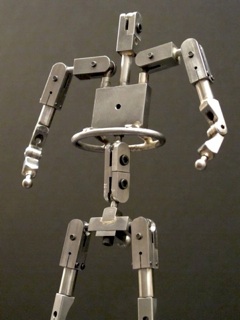
What materials you prefer to use and why?
Every material has a place in the puppet-maker's toolkit. A puppet's head might be made from polymer clay in order to gain more working time while sculpting — whereas the hands and feet might be made of quick-curing epoxy (much stronger) to avoid being broken, since they're so close to high-stress joints. For humanoid puppets I like to use hard parts whenever possible, so that I don't have to fuss with re-sculpting soft clay mid-shot. But, on the other hand, I also like working with clay on its own terms. I think that animating with clay can be like having a 3-dimensional sketchbook... It allows you to improvise and explore ideas in ways that build-up and cast puppets don't. For any kind of artist, I think it's important to make improvisation a regular practice. Make elegant puppets — but also play with shapeless blobs. Ultimately, I think it's good to avoid getting stuck in one set of materials; you should strive to have all of them at your disposal, and know which is right for a particular job.
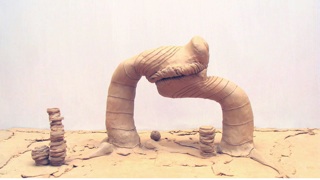
In your point of view, how does social media and technology influence modern stop-motion animation?
Stop-motion has undergone a technological revolution in the past 15 years. With the advent of frame-grabbing software, animators have the ability to toggle back and forth between frames, making sure that they're getting the shot they want. Before this, animators used tools like surface gages (many still do) — but mostly had to rely on sheer mental focus to keep track of what bits were changing between shots. Subtle stop-motion is still challenging — but far easier now that you can check your work before committing.
The internet and forums such as StopMotionAnimation.com and AnimateClay.com have also played a huge role in stop-motion's renaissance. It used to be extremely difficult to find good information about how to make our specialized puppets. Now there's an active online community where masters and amateurs co-mingle, solving problems and learning from one another. Some of the magic may have been lost in the process of revealing the art form's secrets — but as a result, an art that once seemed on the brink of extinction is prospering again.
I think stop-motion is particularly suited to communal discussion, too. With computer animation, it can be challenging to explain what's going wrong with your software. Stop-motion, by contrast, is all about craft projects. "Show and tell" is much more intuitive when you're working with real, tangible materials like clay and wire and foam.
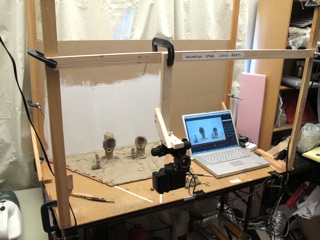
The web is a godsend for stop-motion animators as people. It's difficult enough to find in-the-flesh communities of animators. When you do, stopmoes are usually a minority. Being able to Google "stop motion" and find a bunch of people doing the same sort of work breaks the isolation — and then allows friendships to form. My most valued circle of stopmo friends is made up of individuals living in Los Angeles, San Diego, New Orleans, Atlanta... While I'm all the way up here in Portland. We keep up with each other via show-and-tell on our blogs, through "hey, have you seen this?" emails, and the background noise of Twitter. We've kept tabs on one another during hurricanes and earthquakes, when there's a medical crisis, or when someone just goes missing for a while. ...But of course, that story of "internet relationships extending into the real world" has been true for many types of online affinity groups, not just our own.
Technologically, the most curious thing to me is seeing stop-motion beginning to become indistinguishable from computer animation. The advent of rapid-prototyping 3D printers means that objects for stop-motion are being created first in the computer, then translated into real sapce. Motion control cameras allow dizzying moves that were the sole purview of CG not long ago. When Coraline came out, the stop-motion community seemed torn about how to feel... On the one hand, the technological accomplishment was unprecedented. On the other, the quirky jerky movement usually associated with our hand-made films seemed to be disappearing.
Since Coraline, rapid prototyping technology has spread rapidly among professional stop-motion studios... And it looks like LAIKA's follow-up to Coraline — titled ParaNorman — will push the limits of technology even further. I have no crystal ball — but it seems like in the near future, most of what CG can do (with the exception of large crowd scenes) will be able to be accomplished in stop-motion with nearly identical results. Then what? ...Frame-by-frame hand-drawn animation has been on the wane for a while — perhaps it will have a resurgence. We crave uniqueness. Just as with stop-motion, what's currently being ignored will soon start to look fresh and new.
posted by sven | permalink | categories: stopmo, writing
April 21, 2012
review: portland animation now! @ cinema pacific
by sven at 9:20 pm
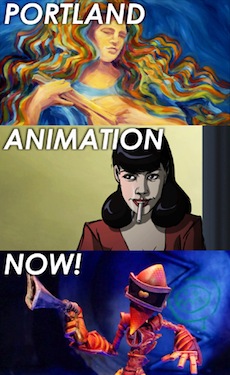
We've just finished showing Portland Animation Now! at the Cinema Pacific festival. It was exciting to take a NW Animation Fest show out to another city for the first time.
As its website says, Cinema Pacific is "an annual film festival based at the University of Oregon in Eugene that is devoted to discovering and fostering the creativity of international films and new media from Pacific-bordering countries, including the U.S." After seeing the original PAN! show back in January, Cinema Pacific director Richard Herskowitz contacted me with a proposal to screen it at his festival on April 20. How could I refuse?
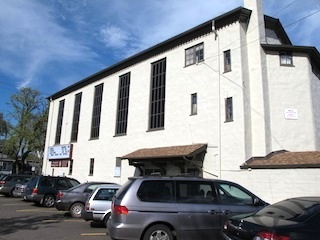
Our show took place at the much loved Bijou Art Cinemas. The historic building began as a church, then was used as a mortuary for a number of years, before finally becoming a movie theater. Great place!
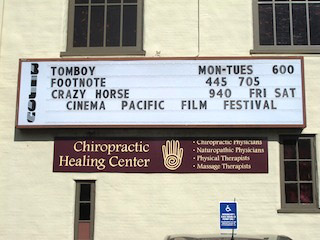
Since Cinema Pacific was hosting the show, a lot of the advance work I usually do was unnecessary. I didn't have to do press releases, invitations, and publicity. I didn't have to organize event staff, coordinate with the theater beforehand, or host an after-party.
Even so, there was still much to do. I needed to get permission from each of the 20 filmmakers involved. One declined, so I scrambled and managed to get master animators Joan Gratz and Jim Blashfield to share two of their films instead. The projection DVD had to be painstakingly remastered. I also put together a batch of fancy new programs for the audience.
There's a temptation to slack off when doing a repeat show under someone else's banner. I remind myself: every show is someone's first impression of the festival — it's important to present the best possible show every time.
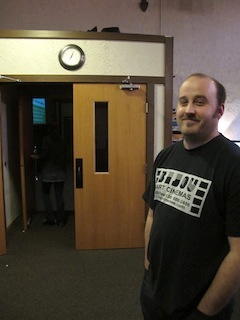
The long-time owner of the Bijou passed away about two years ago. Edward Schiessl has since taken over, and seems to be doing a really great job putting in new equipment and programming films that connect with his audiences. He was warm, down-to-earth, and a pleasure to work with.
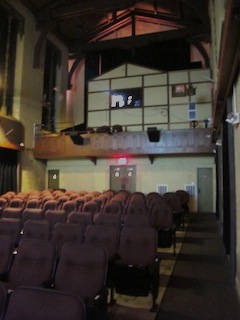
As it turned out, we had our pick as to which auditorium PAN! would screen in. Auditorium 1 was very impressive, with high vaulted ceilings, a 27-foot screen and capacity for 105 people.
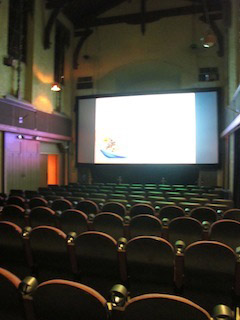
However, talking it over with Gretchin, we decided that if I was running Q&A after the show then auditorium 2 — which has a more intimate feel — would be the better choice.
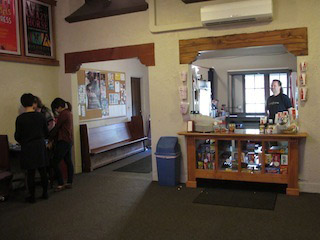
So we trundled over from auditorium 1 through the lobby...
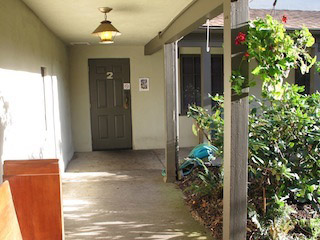
Passing through the theater's beautiful enclosed courtyard...
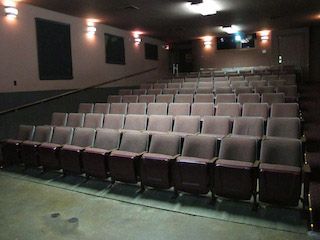
Auditorium 2 has a slightly subterranean feel to it. In a good way, though! Like the cinematic equivalent of a hobbit hole.
Low ceilings help amplify sound when you're speaking from the front of the room. There's more of an incline to the seating than in auditorium 1. Seats, screen and carpets are all in good condition; capacity is 97 people.
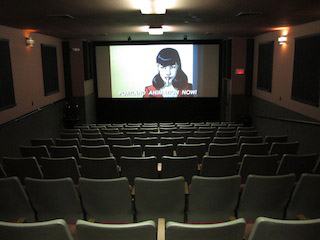
Edward obliged a tech check. Everything seemed good: picture was in focus, aspect ratio correct, sound level neither too loud nor too soft, and we got a small portable amp set up with two microphones.
Gulp. Looks like we're good to go!
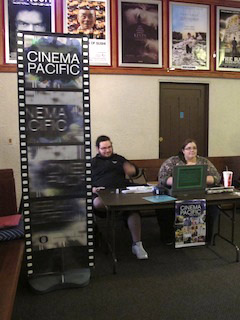
Separate from the Bijou's box office, Cinema Pacific had a table in the lobby for anyone buying tickets on the night of the show. I checked and made sure that the comp tickets promised for my animators were ready and waiting for their arrival.
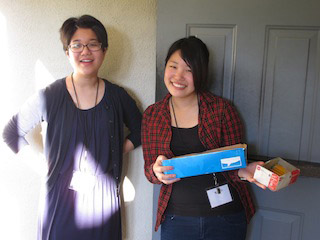
I had put together a short survey for audience members, which was slipped into the PAN! program. As it turned out, Cinema Pacific was also doing surveys. Oops. After conferring, we all decided to slip the Cinema Pacific surveys into the PAN! programs, so as not to bombard attendees with too many loose papers. Even so, it felt a bit embarrassing to ask the audience to fill out two separate questionnaires. Next time, it would be wise to check with the host organization first.
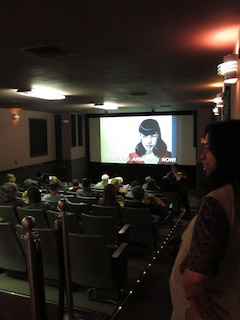
People didn't really start arriving until 10 minutes before the film, with a majority showing up in the last 5 minutes. It was a bit nerve-wracking, pacing the courtyard, reviewing my introductory notes, wondering if anyone was going to come. But this is also sort of what happened when we did our Best of the Fest event at the Hollywood Theatre. A lot of people aim to arrive at the last minute — we have to plan for that.
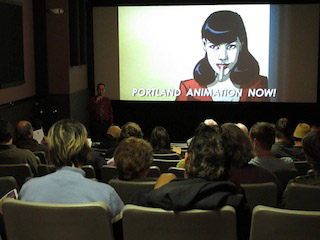
After a brief introduction from one of the Cinema Pacific event coordinators, I gave a little welcome speech. I knew from previous experience: keep it short — get to the films.
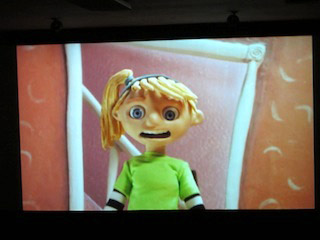
The lights went down, and the films began. To my surprise, there was a much different feel in the house from when we've done our other events. Previously, I've always made a big deal about the makers of the films being in the audience. There's a sense of excitement in the air. People applaud after each short. This time, though, it felt like the audience wasn't prepared to be socially engaged; they were simply there to watch a film, just like any other.
After the first short ended, Gretchin and I started to applaud. There was NO similar response from anyone else, so we stopped that immediately.
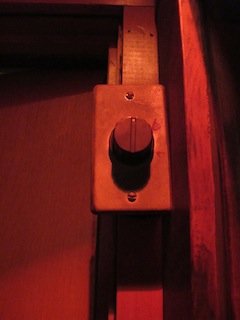
Despite the general lack of excitement, I was very relieved to hear the audience having audible emotional responses to the film. All the funny shorts got chuckles. There was a little gasp when we briefly see the main character in Ursula 1000 - Rocket topless. And once again, someone exclaimed "YEAH!" when the second Ruby Rocket short comes on.
Everything was going pretty well until Chef Antonio came on. The sound was was distorted due to being too loud. I rushed over to the projection booth...
The projection booths that I've encountered so far are universally a bizarre mix of super-new digital technology and old film canisters that have likely been hanging around since the 70s. This one was no different. It has a nice feature, though, which I'd been introduced to earlier: a master volume knob positioned at the door, so you can quickly adjust volume on the fly. Very handy, since folks in the projection booth seldom have an accurate sense of how loud a film is in the auditorium.
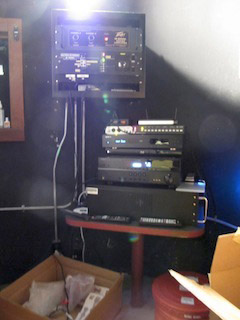
I started fussing with the volume when suddenly crisis struck: the sound cut out entirely!
I ran to the lobby as fast as I could and got Edward. He came and quickly fixed the problem, while the film was still in motion. The sound cut out once more during the Chef Antonio— but was then fine for the rest of the program.
What was the problem? It seems that this particular sound system has a "feature" that causes it to cut out if there's clipping on the film's audio track — supposedly to protect the speakers from damage. After it cuts out, you have to hit the on/off switch to reboot.
I've tried to be very careful about eliminating clipping in the films I receive, adjusting levels during the DVD mastering process to avoid this problem. I never expected, though, that there would be such a horrifying punishment if I missed an overly-loud spot in a soundtrack!
The same film has been fine in the other theaters where it's played... But now I know that some equipment will bring the entire show to the stop if I make this mistake again. Painful lesson!
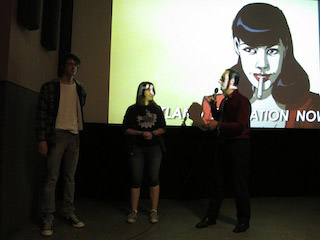
A few Portland animators thought that they'd be able to make it down to Eugene for the show. In the end, only Matthew Dan (Chef Antonio) and Cassandra Worthington (Button Song) could be on hand. Not a problem... Taking a suggestion from Gretchin, I shifted the focus of the talk away from interviewing the artists, and made it more of an "art appreciation 101" spiel.
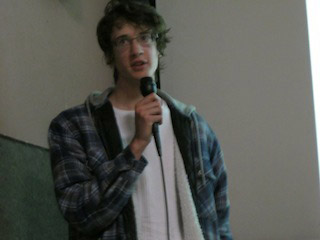
After the film ended, the first thing I did was welcome the animators down to the stage with me. I asked the audience to give Matthew a very special round of applause, since he'd driven all the way from Portland and then had the bad luck of seeing his film suffer technical difficulties.
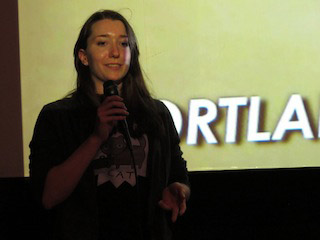
It was an awkward situation, but I'm pleased with how I spun it. I could have been apologetic about the technical failure — instead, this was an opportunity for the audience to extend some empathy to the filmmaker. Finding a way to bridge the emotional distance between the stage and everyone seated in the audience is a delicate art... This improvised solution seemed to work pretty well.
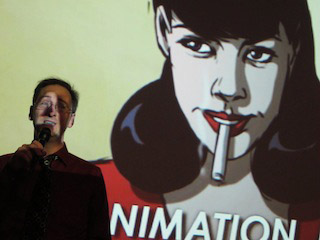
Something I only learned after the Q&A was over: the PAN! menu screen had been projecting across my face the entire time. It looks pretty strange in a lot of the photographs — and was distracting enough that someone actually mentioned it on their survey. Live and learn...
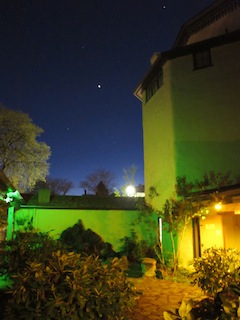
After it was all over, we emerged into a beautiful warm night in the Bijou's courtyard. Venus beamed down from her perch in the wide cerulean sky.
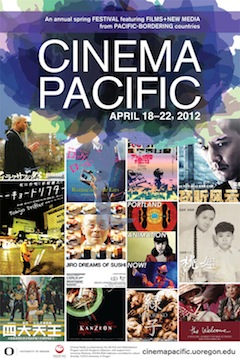
Thank you to Richard Herskowitz and Larissa Ennis at Cinema Pacific for setting us up with this screening opportunity; to all of the kind Cinema Pacific volunteers overseeing the event; to Edward Schiessl for his grace under pressure and a good conversation; to all the filmmakers who contributed their fine work to the show; to Matthew Dan and Cassandra Worthington for joining me onstage; and to Gretchin Lair for help preparing the programs, driving us to Eugene, managing lobby matters, and tremendous support in every aspect of the NW Animation Fest..
Next up: The 2012 Northwest Animation Festival — with nearly 60 films from 15 countries — will play on May 18-19 at the Hollywood Theatre here in Portland. Tickets on sale now!
posted by sven | permalink | categories: nw animation festival